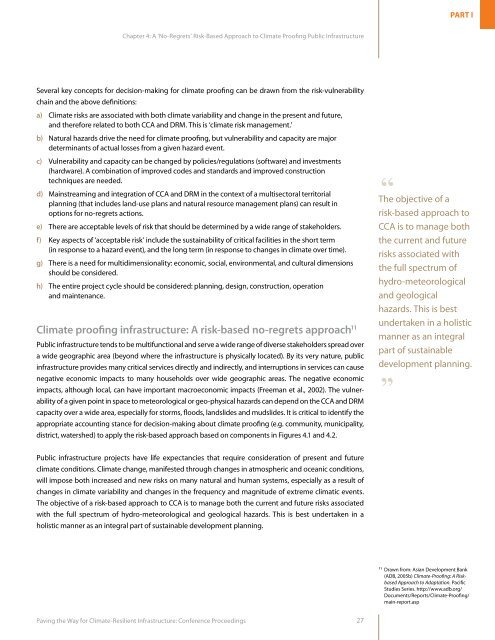Paving the Way for Climate-Resilient Infrastructure - UN CC:Learn
Paving the Way for Climate-Resilient Infrastructure - UN CC:Learn
Paving the Way for Climate-Resilient Infrastructure - UN CC:Learn
You also want an ePaper? Increase the reach of your titles
YUMPU automatically turns print PDFs into web optimized ePapers that Google loves.
PART IChapter 4: A ‘No-Regrets’ Risk-Based Approach to <strong>Climate</strong> Proofing Public <strong>Infrastructure</strong>Several key concepts <strong>for</strong> decision-making <strong>for</strong> climate proofing can be drawn from <strong>the</strong> risk-vulnerabilitychain and <strong>the</strong> above definitions:a) <strong>Climate</strong> risks are associated with both climate variability and change in <strong>the</strong> present and future,and <strong>the</strong>re<strong>for</strong>e related to both <strong>CC</strong>A and DRM. This is ‘climate risk management.’b) Natural hazards drive <strong>the</strong> need <strong>for</strong> climate proofing, but vulnerability and capacity are majordeterminants of actual losses from a given hazard event.c) Vulnerability and capacity can be changed by policies/regulations (software) and investments(hardware). A combination of improved codes and standards and improved constructiontechniques are needed.d) Mainstreaming and integration of <strong>CC</strong>A and DRM in <strong>the</strong> context of a multisectoral territorialplanning (that includes land-use plans and natural resource management plans) can result inoptions <strong>for</strong> no-regrets actions.e) There are acceptable levels of risk that should be determined by a wide range of stakeholders.f) Key aspects of ‘acceptable risk’ include <strong>the</strong> sustainability of critical facilities in <strong>the</strong> short term(in response to a hazard event), and <strong>the</strong> long term (in response to changes in climate over time).g) There is a need <strong>for</strong> multidimensionality: economic, social, environmental, and cultural dimensionsshould be considered.h) The entire project cycle should be considered: planning, design, construction, operationand maintenance.<strong>Climate</strong> proofing infrastructure: A risk-based no-regrets approach 11Public infrastructure tends to be multifunctional and serve a wide range of diverse stakeholders spread overa wide geographic area (beyond where <strong>the</strong> infrastructure is physically located). By its very nature, publicinfrastructure provides many critical services directly and indirectly, and interruptions in services can causenegative economic impacts to many households over wide geographic areas. The negative economicimpacts, although local, can have important macroeconomic impacts (Freeman et al., 2002). The vulnerabilityof a given point in space to meteorological or geo-physical hazards can depend on <strong>the</strong> <strong>CC</strong>A and DRMcapacity over a wide area, especially <strong>for</strong> storms, floods, landslides and mudslides. It is critical to identify <strong>the</strong>appropriate accounting stance <strong>for</strong> decision-making about climate proofing (e.g. community, municipality,district, watershed) to apply <strong>the</strong> risk-based approach based on components in Figures 4.1 and 4.2.‘‘ The objective of arisk-based approach to<strong>CC</strong>A is to manage both<strong>the</strong> current and futurerisks associated with<strong>the</strong> full spectrum ofhydro-meteorologicaland geologicalhazards. This is bestundertaken in a holisticmanner as an integralpart of sustainabledevelopment planning.’’Public infrastructure projects have life expectancies that require consideration of present and futureclimate conditions. <strong>Climate</strong> change, manifested through changes in atmospheric and oceanic conditions,will impose both increased and new risks on many natural and human systems, especially as a result ofchanges in climate variability and changes in <strong>the</strong> frequency and magnitude of extreme climatic events.The objective of a risk-based approach to <strong>CC</strong>A is to manage both <strong>the</strong> current and future risks associatedwith <strong>the</strong> full spectrum of hydro-meteorological and geological hazards. This is best undertaken in aholistic manner as an integral part of sustainable development planning.11Drawn from: Asian Development Bank(ADB, 2005b) <strong>Climate</strong>-Proofing: A RiskbasedApproach to Adaptation. PacificStudies Series. http://www.adb.org/Documents/Reports/<strong>Climate</strong>-Proofing/main-report.asp<strong>Paving</strong> <strong>the</strong> <strong>Way</strong> <strong>for</strong> <strong>Climate</strong>-<strong>Resilient</strong> <strong>Infrastructure</strong>: Conference Proceedings 27
















